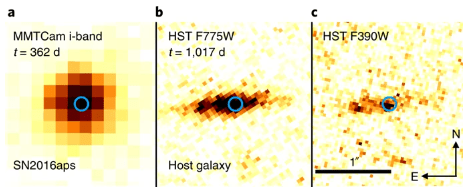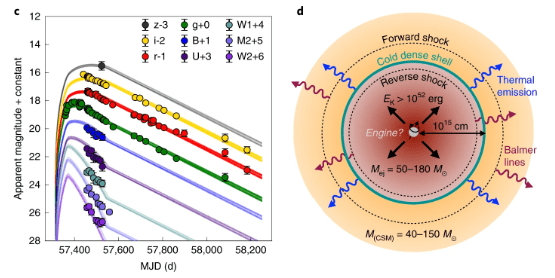It’s easy to run out of superlatives and adjectives when your puny human language is trying to describe humongously-energetic events in the Universe. So now it’s down to this: a really powerful supernova is a “super-supernova.”
But whatever name we give it, it’s a monster. A monsternova.
In 2016, a team of astronomers identified a supernova in data from Pan-STARRS (Panoramic Survey Telescope and Rapid Response System.) The supernova was named SN2016aps, and this monsternova produced ten times more energy than a “normal” supernova.
In fact, this monsternova is the most energetic supernova ever found.
“SN2016aps is spectacular in several ways.”
Professor Edo Berger, Study Co-Author, Harvard University
The team of astronomers who found this monsternova published their findings in the journal Nature Astronomy. The paper’s titled “An extremely energetic supernova from a very massive star in a dense medium.” Lead author of the study is Matt Nichol, of the University of Birmingham.
SN2016aps, the monsternova, is a specific type of supernova called a ‘pulsational pair instability’ supernova. There are several different types of supernovae, and they’re distinguished by the presence of different chemical elements, and by their light curves. Also by what they leave behind.
This ‘pulsational pair instability’ monsternova is a little different. It may have formed from the result of two massive stars that merged prior to the explosion. That’s why SN2016aps’ explosive energy was ten times greater than a typical supernova.
Harvard University Professor Edo Berger is one of the co-authors of the new paper. In a press release Berger said, “SN2016aps is spectacular in several ways. Not only is it brighter than any other supernova we’ve ever seen, but it has several properties and features that make it rare in comparison to other explosions of stars in the universe.”
When it was first discovered, the monsternova had a very high magnitude. It also had a very large brightness contrast compared to its host galaxy, which had previously been undetected. For those reasons, the team of astronomers selected it for follow-up spectroscopy with the MMT Observatory. They also imaged it with the Hubble Space Telescope.
Though initially the team wasn’t certain it was a supernova, follow-up imaging showed that it was, and that it must’ve had a massive star as its progenitor. “The intense energy output of this supernova pointed to an incredibly massive star progenitor,” said Berger. “At birth, this star was at least 100 times the mass of our Sun.”

One of the unusual things about SN2016aps is the spectra. While the spectra are very close to those from a super-luminous supernova (SLSN), and the peak magnitude similar to the most luminous events we know of, there’s one key difference. The monsternova has an unprecedented combination of a very high peak luminosity similar to some SLSN’s, but also a slow rate of fading. It’s slow fade rate more closely resembles long-lived events. And those long-lived events are thought to have a more extended circumstellar medium (CSM,) or shell of gas surrounding them.
“Spectroscopic observations during the followup study revealed a restless history for the progenitor star,” said Matt Nicholl, lead author of the study. “We determined that in the final years before it exploded, the star shed a massive shell of gas as it violently pulsated. The collision of the explosion debris with this massive shell led to the incredible brightness of the supernova. It essentially added fuel to the fire.”

Study co-author Edo Berger pointed out that the monsternova had several rare properties and features. One of them was the presence of hydrogen gas.
Massive stars like SN2016aps’ progenitor typically lose their hydrogen to their own stellar wind, long before they begin to pulsate. But all of the hydrogen led the team to theorize that there were two progenitor stars.
“That SN2016aps held onto its hydrogen prompted us to theorize that two less massive stars had merged together, since lower mass stars hold onto their hydrogen for longer,” said Berger. “The new star, borne of the merger, was heavy with hydrogen and also high enough in mass to trigger pair instability.”
According to co-author Berger, this discovery will lead to more study and understanding of monsternovae, or extremely luminous supernovae. Especially when the transient-finding specialist Vera C. Rubin Observatory comes online, hopefully later this year. Super massive stars were thought to be more common in the Universe, and the Vera Rubin should be able to find them.
“The identification of SN2016aps has opened pathways to identifying similar events from the first generations of stars. With the upcoming LSST (the former name of the Vera Rubin Observatory) we can find such explosions from the first billion years in the history of the universe, and there will be plenty of examples then.”


NO !!! Not a SUPER-SUPER NOVA !!! …. He must have been double dogged dared.